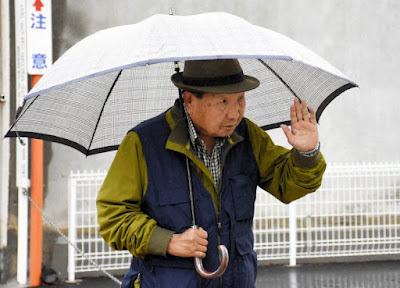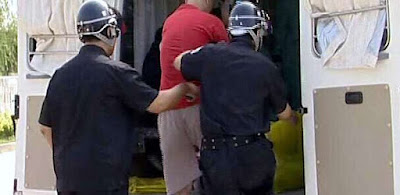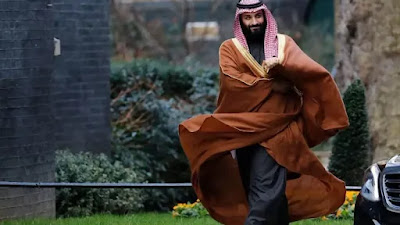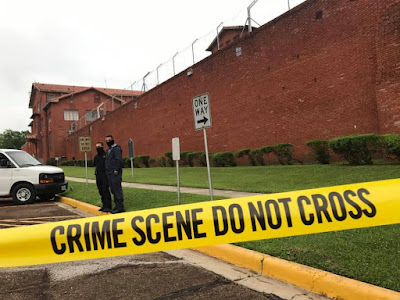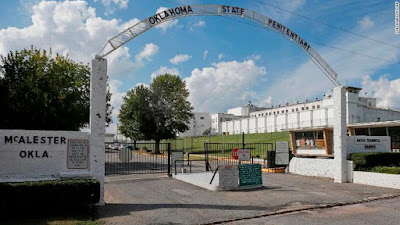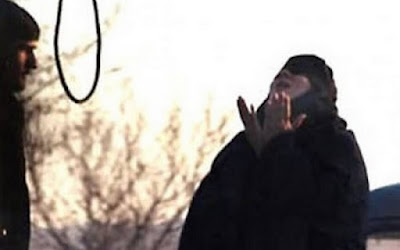Draper, Utah (CNN) -- Convicted killer Ronnie Lee Gardner was executed early Friday by firing squad, the Utah Department of Corrections said.
Gardner, 49, is only the third person in 33 years to die by firing squad in the United States.
He was killed at 12:20 a.m. MST (2:20 a.m. ET), a Corrections Department spokesman said.
A hood was placed over Gardner's head and a paper target pinned to his chest. He was heavily restrained as a five-person firing squad took aim at the target and shot him, witnesses said.
Journalists who witnessed the shooting said it happend quickly. One reporter said she noticed that Gardner moved after he was shot.
"It was over pretty quickly," said Cheryl Worsley, a local radio reporter. "It was cleaner than I expected. It was fast. But he moved. He moved a little bit, and to some degree that bothers me."
Outside the prison in Draper Utah, there was a candlelight vigil attended by members of Gardner's family.
"He did things bad in the past, but now he realizes what he did and he changed the last couple of years," said his granddaughter Darian Gardner, breaking into tears. "I got to know him the last couple of years. It sucks when you have to say goodbye to someone that is like your best friend."
The execution came after Gardner's last-ditch efforts to save himself had failed.
The U.S. Supreme Court rejected a request Thursday to temporarily stay the execution. Utah Gov. Gary Herbert rejected two appeals by Gardner's attorneys to stop the execution, saying he had every chance to present his case.
Gardner, 49, was convicted for the shooting death of attorney Michael Burdell during a botched escape attempt from custody in 1985 at a Salt Lake City, Utah, courthouse.
Among the claims Gardner raised in his appeals is that he has been a death-row inmate for too long.
"He asserts that executing him now, after nearly 25 years on death-row in Utah, so lacks retributive or deterrent value that it violates the Eighth Amendment," Andrew Parnes, Gardner's lawyer, told the high court.
A federal judge late Tuesday declined to block the execution, after Gardner claimed the procedures related to a two-day commutation hearing held by the state Board of Pardons and Parole last week violated his civil rights. The parole board Monday declined to commute Gardner's sentence to life in prison, and the Utah Supreme Court on Tuesday also denied his request for a stay.
Gardner was the third person to die by rifle fire, all in Utah, since the Supreme Court restored the death penalty in 1976. He had a long history of escapes and was slipped a gun before he fatally shot Burdell on April 2, 1985. He was at the courthouse for a pre-trial hearing in the 1984 slaying of Melvyn Otterstrom, who was killed at the Salt Lake City bar where he was working to earn extra money.
Corrections officials announced Gardner had consumed his last meal Tuesday night at 6:30 p.m., and chose to fast prior to the anticipated execution. His dinner included steak, lobster, 7-Up, apple pie and vanilla ice cream.
Source: CNN.com, June 18, 2010
Ronnie Lee Gardner Executed By The Utah Firing Squad
Ronnie Lee Gardner, a death row prisoner was shot dead by Utah firing squad in the early hours of Friday. This is reported to be the first firing execution of Utah in the span of 14 years.
It was Ronnie Lee Gardner himself, who choose the controversial firing squad option over lethal injection method adopted by Utah in the year 2004.
Gardner was shot on his chest by certified police officers, who volunteered for the task. He was declared dead at 12:20 a.m.
Members of Gardner’s family held a vigil outside the prison as he was shot. Some described it as a barbaric act.
Ronnie Lee Gardner was sentenced to death for gunning down an attorney in a failed escape attempt from a courtroom in 1985 during a murder trial.
Ronnie Lee Gardner was the third man to be killed by state marksmen since 1976. The other two were Gary Gilmore, who was shot on January 17, 1977; and John Albert Taylor on January 26, 1996.
Source: UKTodayNews.com, June 18, 2010
Protesters pray, plead for end to capital punishment
Scores of somber death-penalty opponents gathered in a cold wind on the Utah Capitol steps Thursday night to share their distress that their state was executing Ronnie Lee Gardner.
And yet several speakers struck a note of hope:
"This is not the end of the movement," said Ralph Dellapiana, a defense attorney and one of the founders of Utahns for Alternatives to the Death Penalty, a new group that sponsored the protest. "This is the beginning."
Kent Hart, also a defense attorney, introduced himself with a reference to his religion, The Church of Jesus Christ of Latter-day Saints.
"The Mormon issue is kind of the elephant in the room," said Hart, who has met with eight of the nine men left on Utah's death row. Hart encouraged Latter-day Saints to reconsider the implications of capital punishment. The Salt Lake City-based church officially is neutral.
"I am not delusional. I'm not saying we're going to abolish the death penalty a week from now or next year," Hart said. "But I think we can do it. We'll do it in the name of people like Ronnie Lee Gardner."
The rally was at the Capitol, Dellapiana said, to pressure lawmakers to end capital punishment, as many other states have done. Several members of Gardner's extended family attended the rally, but declined to comment.
Many in the crowd of about 150 protesters were young people carrying handmade signs such as "25 years can change a man! We are not God!" and "Capital punishment is the most premeditated of murders."
Candles were passed around, but few remained lit in the brisk wind.
Perhaps the most-poignant comments came from two people who were with condemned Utah men in the hours before their deaths: a legal studies professor from Utah Valley University and a former Catholic chaplain.
Sandra McGunigall-Smith studied death-row inmates at the prison for several years, and was with Joseph Parsons in the hours before he was executed
If the state wants true and proportional punishment, she said, it should sentence killers to life without parole.
"The life-sentenced prisoners have no way to end their suffering," McGunigall-Smith added. "Prison itself becomes a cemetery, the cell a tomb."
Reyes G. Rodriguez, a Catholic chaplain at the prison for seven years, says he was with John Albert Taylor in the hours before he was shot by firing squad in 1996.
"A soon as they said, 'Fire,' I closed my eyes," Rodriguez said. "That was a very sad, sad event, to see a life just destroyed."
At a protest near the prison, Salt Lake City resident Kristin Powers arrived shortly after 11 p.m. with a handwritten sign reading, "Who would Jesus execute?"
Ron Belnap, a retired priest from All Saints Episcopal Church in Salt Lake City, said he "felt like this was a place for me to be."
"Murder is wrong, he said. "That is true regardless of whether you are a murderer or a government that takes the life of a murderer."
Dozens of Gardner's family members, mingling with the protesters, carried red and white balloons with messages written on them for the condemned killer. They planned to release the balloons at the time of his death.
Not far away were family members of Gardner's victims.
"I had an abusive upbringing. I know people who have done drugs, but we've never killed anyone," said Kearns resident Wayne Hunting while standing with family members of bailiff Nick Kirk, who was wounded in Gardner's 1985 escape attempt. "It's all about taking responsibility for our actions."
Earlier Thursday evening, prayers for Gardner, his victims, their families and his executioners were sent up by about 125 people who gathered at St. Mark's Episcopal Cathedral in downtown Salt Lake City.
"Violence breeds violence," said the Rev. David Henry, interim pastor at First Baptist Church. He urged others to pray that the state soon ends capital punishment.
"It doesn't work," Henry said. "It's ineffective, and it's brutalizing all of us."
Michael Bulson, a deacon at St. Andrew Catholic Parish in Riverton and an attorney, said he learned a lesson from the father of a woman killed in the 1995 Oklahoma City bombing.
"Hate and revenge will not bring about the healing that is needed," Bulson said.
Ogden resident Victoria Sethunya, a native of Lesotho, said she was stunned to learn that Utah still executes killers.
"This is a sacred place," she said. "I grew up thinking only God takes life."
Sandy resident Diana Mafi, a born-again Christian, said she attended the vigil because she cannot share her dismay over capital punishment with family or friends.
"I feel bad about the people who think they can feel better killing another person."
Source: The Salt Lake Tribune, June 18, 2010 - Photo: Brandie Gardner, right, the daughter of Ronnie Lee Gardner, is consoled by her friend Debbie Evans, left, just before the execution of Ronnie Lee Gardner by firing squad on Friday.
9 remain on Utah's death row; the next to be executed is unclear
SALT LAKE CITY — Ronnie Lee Gardner's Friday execution now leaves nine men on Utah's death row.
Four of them could face a firing squad, while the others face lethal injection. But no one can say when those sentences will be carried out.
"I would never hazard a guess," said Tom Brunker, head of the Utah Attorney General's Office capital crimes team.
Gardner's death by firing squad early Friday morning was Utah's first execution in 11 years. There has been seven men executed in the state since 1976.
All nine death row inmates have appeals pending in either state or federal court not necessarily challenging their convictions, but questioning the constitutionality of the death penalty.
Douglas Stewart Carter, who fatally stabbed and shot a Provo woman in 1985, is furthest along in the legal process, but that doesn't mean he would be the next man executed, Brunker said. Carter has appeals pending in both state and federal court.
Capital cases are complicated and filled with volumes of paperwork in the form of court motions, briefs and legal arguments. Von Lester Taylor, for example, filed a 500-page document in his case. Taylor killed two woman during a cabin robbery in 1990.
Source: Deseret News, June 18, 2010
Ronnie Lee Gardner executed by firing squad
Ronnie Lee Gardner, who a quarter century ago put bullets into the heads of 2 good men, died in the earliest minutes of this morning with wounds from 4 .30-caliber rifle rounds in his chest.
He became the 3rd inmate in Utah — and the United States — to be executed by firing squad since a nationwide moratorium on the death penalty was lifted in 1976 and the first since John Albert Taylor's execution in 1996.
Just after midnight, five anonymous executioners raised their rifles and fired from behind curtains and a ported brick wall. One rifle held a blank round, leaving room for doubt in the minds of the marksmen. Gardner was pronounced dead at 12:17 a.m.
He died strapped in a chair, a hood over his head and a white target on his heart.
Gardner's path to execution began in 1985, when he was sentenced to death for shooting and killing attorney Michael Burdell during an attempted escape from a Salt Lake City courthouse in April of that year. An accomplice smuggled a gun to Gardner while he was in the courthouse on charges of killing Melvyn John Otterstrom during a 1984 robbery at Cheers Tavern.
In the escape attempt, Gardner also shot and wounded George "Nick" Kirk, a bailiff, whose family said he died 11 years later as a result of his injuries.
Though Gardner wavered at times in his efforts to fight his execution, he and his attorneys launched numerous appeals in state, federal and appellate courts.
During his final hours of life, both the U.S Supreme Court and Gov. Gary Herbert denied requests to stay Gardner's execution. Herbert twice denied last minute attempts by Gardner's attorney to spare his client's life.
"No court has given us a full and fair adjudication," attorney Andrew Parnes told reporters Thursday evening as he arrived at the prison to inform his client of the decision from the nation's high court. "It's a shame, because if they had, Ronnie Gardner would have a life sentence."
As he had numerous times in a courtroom, Parnes pointed to Gardner's troubled upbringing — a sordid history of physical and sexual abuse, neglect and a drug addiction that started when he was just 5 years old — as the reasons to spare his life.
"We as a society didn't give him the benefit we give a lot of people," Parnes said. "He really is a changed person. … He understands now what created him."
In a parking lot overlooking the prison where Gardner spent more than 1/2 his 49 years, friends and family hugged and wiped tears from their eyes as the execution approached.
"It's hard to say goodbye to somebody you love," said Brandie Gardner, who grew up with her father behind bars.
Gardner's brother, Randy Gardner, said his brother had changed over the last decade and had hoped to help start an organic farm to benefit troubled youths.
Gardner had been on Utah's death row since October 1985. He lived in a 6-by-12 cell in Uinta 1, a maximum-security facility in the prison. He slept on a thin mattress atop a hard bunk. His cell's only other amenities were a stainless steel toilet, a sink, a mirror and a small window that overlooked part of the prison yard.
Wednesday night, for the 1st time in about 25 years, Gardner was permitted to reach through the bars of his cell and touch his family.
"He's never touched no one but his lawyer's hand" since coming to prison, Randy Gardner said.
In the midst of those who loved Gardner, there were some who never knew him at all, but wanted to offer support — even if he had killed someone they had loved.
Donna Taylor, Burdell's niece, and her husband, Lynn, sought out Gardner's family early on, to let them know that there are people who care about them.
"We put it behind us 25 years ago when it happened," she said. "We didn't like that they kept saying he's being killed because he killed Mike. … This is the last thing (Burdell) would have wanted. I just hate that his family has to go through this now."
She said many members of her family have felt angry "like they were shut out" when they constantly tried to point out that Burdell wouldn't have wanted to see Gardner die on his behalf. But she is certain that the two men will meet, and there will be no qualms between them.
"I think Mike will be right there to welcome him home," she said. "You just forgive, you just do, and if you don't forgive, it just hurts you. Michael is at peace. He's fine."
Gardner's family said they would not witness the execution.
"He don't want that to be our last image," Randy Gardner said. "He don't want us to have nightmares and bad dreams."
Gardner fasted from food in the 36 hours leading up to his death, drinking only vitamin water, Sprite, Coke, 7UP and Mountain Dew, prison officials said. Gardner ate his last meal Tuesday evening.
Department of Corrections spokesman Steve Gehrke said Gardner was moved to a smaller observation cell after meeting with family Wednesday night.
In the hours leading up to his execution, prison officials described Gardner's mood as "reflective" and "calm." Gardner slept, read mail and David Baldacci's "Divine Justice," a novel about a former CIA assassin. Gardner intermittently slept and watched "The Lord of the Rings" trilogy.
By 8:45 p.m., Gehrke said Gardner had met with an LDS bishop, a person he had known for several years and whom he trusted. Gardner sat on a bunk in the observation cell and spoke to the bishop through a small port used for handcuffing inmates. Gardner finished meeting with his clergy and attorneys by 9:30 p.m., Gehrke said. As the execution neared, family and friends of the condemned killer held a candlelight vigil outside the prison.
They sang along to Lynyrd Skynyrd's "Free Bird," held each other and wept.
Gardner, meanwhile, slept and waited alone until he was escorted 90 feet down a hallway and around a corner to the prison's execution chamber just before midnight.
At 12 a.m., Utah Attorney General Mark Shurtleff spoke with prison officials by telephone and told them there was no legal reason not to go through with the execution.
Families of Gardner's victims and others waited at the Utah State Capitol. The nervous sounds of tapping feet or whispered conversations were all that remained as a small crowd waited for the attorney general to re-emerge. "Ronnie Lee Gardner will never kill again. He will never assault anyone again," Shurtleff said to a silenced audience.
Gardner was pronounced dead at 12:20 and 25 seconds.
"Now Ronnie Lee Gardner will be held accountable to a higher power, and I pray he will find more mercy than he showed his victims," Shurtleff said.
Gardner becomes the 1st condemned inmate to be put to death this year in Utah and the 7th overall since the state resumed capital punishment on January 17, 1977, when Gary Gilmore became the 1st condemned individual to be put to death in the US after the Supreme Court re-legalized the death penalty on July 2, 1976.
Gardner becomes the 29th condemned inmate to be put to death this year in the USA and the 1217th overall since the nation resumed executions in 1977.
Sources: Deseret News & Rick Halperin, June 18, 2010
Firing squad: An eyewitness account of Gardner's execution
Ronnie Lee Gardner's head, covered by a black hood, remained upright. His body sat straight in the chair to which it was strapped.
As my eyes traveled down Gardner's left arm, past his dark blue jumpsuit, I saw his pale white skin appear below his elbow. Half a faded blue tattoo, some kind of diamond shape, stuck out from the restraint around his wrist.
At the bottom of his restraint, I focused on his fist. Gardner died much the way he lived -- with a clenched fist.
Yes, this was my first time witnessing an execution. I have been amazed at how many people asked me that.
Firing 4 bullets into a man's chest is, by definition, violent. If it can also be clinical and sterile, then that also happened in this execution.
8 other journalists and I had our own viewing area with about a 6-foot-wide, bullet-proof window. When the curtain opened, there sat Gardner. We were at about a 45-degree angle to his left.
He looked nothing like the athletic 23 year old with the red hair who murdered Melvyn Otterstrom in a robbery, nor did he flash that grin he had in those infamous photographs of him shackled on the courthouse lawn after killing Michael Burdell and wounding Nick Kirk in 1985.
This time, he looked like Utah's own ghost of Hannibal Lecter. Gardner's skin and his white socks contrasted with the dark blue jump suit he wore and the restraints, chair, wooden backdrop and sandbags, all of which were painted black. Restraints circled his wrists, ankles, shoulders and waist, but the restraint across his forehead best exemplified his confinement to me.
Gardner could not even look around the room and the fluorescent lights in the ceiling tiles illuminated his bald head and pale face.
Over his left breast clung a white square, about 2 inches by 2 inches, with a circle in the middle.
The room had no decor. There was a white tile floor with white cinder block walls. The 2 slits for the shooters sat opposite Gardner and windows for the observers lined the 2 perpendicular sides.
Steven Turley, warden at the Draper prison, picked up a microphone and announced Gardner had 2 minutes to say his final words. When Turley asked Gardner if he had anything to say, Gardner said, "I do not. No." Gardner moved his head ever so slightly trying to shake it.
Gardner's final words were to say he had none.
Turley hung up the microphone. Turley reached up and gently pulled a hood over Gardner's head. Turley picked up the microphone, unplugged its cord from a wall jack, wound the cord in his hand and exited the room.
Over the next 30 seconds, my heart raced. I realized the 5 gunmen would launch their volleys any moment. I placed a Styrofoam plug in my right ear to match the one I had earlier placed in my left. The other reporters and I stood in front of the glass.
I watched Gardner. As the seconds passed, I grew anxious. I pivoted my eyes away from Gardner toward the slits.
In that fraction of a second my eyes were in transit, I heard "boom boom." The sounds were as close together as you could spew them from your mouth.
My eyes darted back to Gardner and to his chest. The target, perfect just a second earlier, had 3 holes. The largest hole was in the top half of the circle and toward Gardner's left side. It may have been where 2 bullets entered Gardner.
Below that hole, still inside the circle, was a smaller hole. Outside the circle, in the bottom right of the target, was a 3rd hole. Each hole had a black outline. Utah Department of Corrections Director Tom Patterson would say later the target was fastened to the jump suit by Velcro and that may account for the black outline.
I watched Gardner's torso. The men who shot John Alberty Taylor in a firing squad in 1996 said they saw Taylor's body slump and I assumed Gardner would, too. But I never saw such a movement.
Instead, a few seconds after the gunshots, I saw Gardner move his left arm. He pushed it forward about 2 inches against the restraints. In that same motion, he closed his hand and made a fist.
Then it happened in reverse. Gardner's hand loosened, his arm bent at the elbow, straightened again and the fist returned. At the time, I interpreted this as Gardner suffering -- clenching his fist in an effort to fight the pain.
As I write this, I don't know whether that's true. It could have just been reflexes or some other process the body begins after a major trauma. Scientists do not know much about what a person shot through the heart feels.
The next movement I saw from Gardner came from beneath his hood. I could see the bottom of his throat and it rippled as though Gardner moved his jaw.
I squinted my eyes, looking for blood. I saw none through the holes in Gardner's chest. None spilled on the floor. The jump suit slightly darkened around his waist and it appeared that's where blood was pooling. But I never saw a drop.
About 2 minutes passed after the gunshots. It was long enough that I wondered (and some of my colleagues later said they wondered, too) whether Gardner would require a 2nd volley of bullets to die.
Through a side door walked a man in a button-down shirt, slacks and blue plastic gloves. He lifted Gardner's hood only enough to check the pulse on the left side of Gardner's neck. The man appeared to do the same on Gardner's right.
Then the man lifted the hood high enough to shine his small flashlight in Gardner's eyes. When he did this I could see Gardner's face. His mouth was agape. His face was even whiter than it was before the hood covered him.
The man withdrew his flashlight and let the hood fall again. He shut off the flashlight and started to walk out of the room. Gardner was dead.
Turley and Lowell Clark, the director of division institutional operations for the Department of Corrections, entered the chamber. Clark grasped the curtain on my side and Turley the curtain on the opposite wall.
As Clark pulled the curtain along its rod, I pushed my head toward the glass to take one final look at the scene. In the final second, my eyes focused on the straightened left arm, seemingly flexing, and that clenched
fist.
Source: Nate Carlisle, Salt Lake Tribune, June 18, 2010
2 loud bangs end 25 years on death row for Gardner
4 bullets.
With 2 loud bangs in quick succession, Ronnie Lee Gardner's quarter century on Utah's death row ended.
At 17 minutes past midnight Friday, Utah Department of Corrections officials confirmed the death of a man whose life was defined by sex abuse, drug addiction, poverty, criminality and murder.
But in the final hours of his life, friends and family members said, Gardner was at peace.
And in his final minutes, witnesses said, the calm, condemned man exchanged private words with Utah's prison chief before being strapped to the execution chair and asked if he had any final words.
"I do not. No," he said.
A hood was pulled over his head. An executioner counted back from five. The shots rang out.
Journey to death row
If the man known as one of Utah's most notorious criminals was a monster, family members said, it was only as a result of his abusive upbringing. And Gardner's appellate attorneys long had argued that if his jurors had known more about his childhood, they would have sentenced him to life in prison, instead of death.
Born in Salt Lake City in 1961, Gardner was 6 when his siblings taught him to huff gas and glue. By age 9, he had landed in state custody for theft. When he was 10, police investigated a report that Gardner had traded a BB gun for marijuana. A stepfather used a teenage Gardner as a lookout while he burglarized homes. A foster father paid Gardner for sex.
In 1980, Gardner was convicted of his first adult crime - a robbery. In 1985, while serving time for a subsequent robbery, he attacked an officer at Salt Lake City's University Hospital, stole his gun, and forced a medical student to help him escape. Two months later, Gardner shot and killed Melvyn Otterstrom, a bartender at Cheers Tavern in Salt Lake City.
Arrested and charged with murder for Otterstrom's death, Gardner escaped from custody when a female accomplice slipped him a gun at a Salt Lake City courthouse. During his escape, Gardner wounded bailiff Nick Kirk and killed attorney Michael Burdell. A jury sentenced him to death.
The intervening 25 years were punctuated by attacks on other Utah State Prison inmates and a standoff in a visiting room during which he broke a glass partition, barricaded the door and had sex with his half-brother's wife as officers looked on helplessly.
At peace with his fate
In a final appeal to the parole board last week though, Gardner described himself as a changed man. His daughter, Brandie Gardner, said she believes that to be true.
"Up until 10 years ago, I would have told you he was a bad person," she said. "But something changed in him."
The convicted killer said he wanted to help sponsor a farm for troubled youth, "so that they don't end up like he did," Brandie Gardner explained.
His appeals exhausted, Gardner spent the final hours of his life in an observation cell about 90 feet from the execution chamber. There, prison officials said, he read a spy novel called "Divine Justice," watched the Lord of the Rings trilogy, consulted with a bishop from The Church of Jesus Christ of Latter-day Saints and visited with his attorneys.
"He was at peace," attorney Tyler Ayres said. "He even laughed a few times during our conversation, and that helped put me at ease."
As Ayres turned to leave, Gardner called out after him, "don't get into any trouble."
"You either," Ayres said, turning back to a man he had come to see as a friend.
Mourning a killer
Under prison policy and state law, Gardner had the right to invite as many as five witnesses to his execution. But in the weeks before he was killed, the 49-year-old prisoner told his loved ones he did not want them to watch him die.
Saying they wanted to respect the condemned man's wishes, while being as close to him as possible in his final hours, more than 20 members of Gardner's family gathered in a parking lot, across the interstate, overlooking the prison where he was to be killed.
"He believes he needs to pay for what he's done," Brandie Gardner said. "He absolutely believes that. But at the same time, people should know that what they're doing is murder."
As the sun set, dozens of death penalty protesters joined family members in a candlelight vigil. One held a sign that read: "Who Would Jesus Execute?" Another implored media onlookers to "tell the world of the barbarity of this act."
Moments after midnight, family members cranked up a car stereo, which played a concert recording of Lynyrd Skynyrd's "Free Bird." They leaned against each other in a tight cluster, sobbing and shouting as they awaited confirmation of Gardner's death.
A sudden, violent death
Gardner was already locked into the chair with 6 thick straps, including one that held his head upright against the chair, when a curtain opened to reveal the death chamber to 9 media witnesses.
"I could see him moving his eyes," television reporter Sandra Yi said.
"He didn't look scared," radio talk show host Doug Fabrizio said.
The prison warden draped the black hood over Gardner's head. A small target was affixed by Velcro over his left breast.
The 5 executioners readied their weapons, only 4 of which were loaded with live ammunition.
At 12:15 a.m., the shots rang out.
"It was so sudden, so quick - boom boom - just like that," television news reporter Marcos Ortiz said.
Several of the witnesses described watching as Gardner's hand and arm continued to move after he was shot.
"He clenched his fist and then let go," Fabrizio said. "And then he clenched it again."
2 minutes after the shots, the medical examiner lifted Gardner's hood to reveal his ashen face, mouth agape.
The killer was dead.
Calls for reform
For the nation, Gardner's death marked what could be the final execution of its kind in the country. Utah is the only state still using a firing squad, and only 4 men on death row could still choose it. The state switched to lethal injection in 2004.
Some hope the attention will highlight problems meting out capital punishment in Utah. Both death penalty opponents and believers decry the nearly 25 years Gardner spent between his conviction for Burdell's murder and the execution.
Utah Attorney General Mark Shurtleff, who has pushed to streamline death row appeals, said the run up to today's execution may have generated legislative momentum to remake state law.
"I'm hearing from a lot of people, 25 years is just too long," Shurtleff said. "It's ridiculous."
Ralph Dellapiana, an attorney affiliated with Utahns for Alternatives to the Death Penalty, said he hopes Gardner's death will spark discussion "that this arbitrary process be changed to something else."
Members of the victims' families argued both for and against Gardner's death. All said they wanted to end a long nightmare.
"This story must be allowed to slip into history," Jason Otterstrom said during the commutation hearing. "Our families need peace."
Barb Webb, daughter of victim Nick Kirk, sobbed when news of the execution came.
"I'm so relieved it's all over," she said, hugging her daughter, Mandi Hull. "I just hope my sister, who just passed away, and my father and all of the other victims are waiting for his sorry ass. I hope they get to go down after him."
Source: The Salt Lake Tribune, June 18, 2010
For a condemned killer's family, one final visit -- Loved ones say he's 'at peace.'
She had one last time to see him. To speak to him. To touch him.
One last time to tell him that she loved him.
But there was one thing she just couldn't bring herself to do.
"I couldn't say goodbye," Brandie Gardner, 33, said of her final visit to her father, Ronnie Lee Gardner.
One by one Wednesday night, 4 family members visited with Gardner, shortly before he was moved to an observation cell near the execution chamber at the Utah State Prison.
Reaching through the bars, the convicted killer took his daughter by the hands. He touched her face. He kissed her head.
"We both cried," Brandie Gardner said. "He told me that he was sorry. And he was at peace."
Gardner also met with his brother, Randy, and son, Daniel, 30.
Then it was Darian Gardner's turn. At 15, the Idaho high school student has never known a time in which her grandfather was not a condemned man. They kept in touch through letters and rare visits.
"For me, this day has always been coming," she said. "I always knew it was going to happen someday."
But that didn't change the way she felt about him. And Wednesday she had one final chance to tell him.
Darian Gardner said she didn't speak to her grandfather about what was to come.
"But I could tell that he wasn't worried about himself," she said. "He was only worried about us. He wanted to make sure we would be OK."
Like her mother, Darian Gardner found it hard to say goodbye.
"So I just told him that I loved him," she said. "And he told me to be strong."
Source: Salt Lake Tribune, June 18, 2010
Rallying Against the Death Penalty
Despite the cold wind, about 200 people sat outside the steps of the Utah State Capitol in protest against the death penalty last night.
49-year-old Ronnie Lee Gardner was pronounced dead at 12:20 a.m. on June 18 after facing a firing squad. Gardner spent nearly 25 years on death row for the 1985 murder of attorney Michael Burdell during an attempt to escape a hearing for the murder of bartender Melvyn Otterstrom in 1984.
Strangers and family members and even former mayor Rocky Andersen alike attended the rally in support of Gardner and to take a stand against the death penalty. Gardner's 1st cousin, who did not offer a name or further comment, said that the family was in mourning.
Rally participants held signs that declared, "Not Fair, Not Just," "Moratorium Now," "The Death Penalty Makes Us All Murderers" and "Pray for the Burdell, Otterstrom and Gardner Families." Although the night was too windy to allow for a candlelight vigil, people in the crowd still raised their candles and held a moment of silence for Gardner.
Ralph Dellapiana, public defense lawyer and director of the Utahns for Alternatives to the Death Penalty, said during the rally that Gardner's life, as well as the lives of others in Utah who have faced the death penalty, was in part on him.
"I felt responsible for his [Gardner's] life, that light which is in each of us," Dellapiana said amidst applause, "and that's when I determined that I'd better try to end the death penalty in Utah."
He added that the community needs to feel that same sense of responsibility in order to make a difference, because "nobody wants to be responsible for anybody else's death."
Criminal defense lawyer and practicing Mormon Kent Hart also spoke to the crowd, acknowledging his faith as to not ignore "the elephant in the room," but also as a way to encourage those of the LDS faith to consider the implications of the death penalty.
Although Hart has not developed a personal relationship with Gardner, he has worked with the other eight out of nine men on Utah's death row and established close friendships with each of them.
According to Hart, Utah still has a long way to go before the death penalty is done away with completely.
"I'm not delusional. I'm not saying we're going to abolish the death penalty next week, or even next year," he said, but added that he believes it can happen.
Former chaplain at the Utah State Prison Brother Rodriguez, who worked at the prison until 1996, recalled the execution of John Albert Taylor. Taylor was executed by firing squad on Jan. 26, 1996, the last execution by firing squad before Gardner's execution.
In 1996 at this hour, I was with Chris Rogers [Taylor's lawyer] and John Taylor in the holding cell," Rodriguez said. "We were all on the floor because there were no chairs."
Taylor was calm, unafraid and accepting of his situation, Rodriguez said. Shortly before midnight, he was told to get ready. The three of them went together "to the same room Ronnie will be going to tonight," he said. Taylor was strapped to the chair, a hood was placed over his head and a marker over his chest. Rodriguez said he sat in one of the two viewing rooms but closed his eyes when the command was given to fire because he did not want to witness the death, re-entering the execution room once Taylor had been pronounced dead.
"There was blood rolling out of his chest," Rodriguez described, bringing tears to the crowd's eyes and reminding them of what was scheduled to happen later that night. Rodriguez commended the crowd for attending, saying that although Gardner will not be able to live out his purpose in life, that purpose will be carried out for him.
Doctor and attorney Clark Newhall said that the death penalty, simply put, "is just stupid."
"We feel like it's wrong for the state, for us, to kill a helpless human in a cage," he said.
Not only is the death penalty unjust, it's wasteful, Newhall added. He said that it's a waste of a human life, what could be done with that life and even of the time and money spent on the executions.
Newhall said that the death penalty reduces the United States to a barbaric, uncivilized nation.
"It takes us out of the realm of civilized cultures and it takes us out of the the realm of reason," he said.
Dellapiana said that though nothing can be done to change Gardner's sentence, it has become clear that he never had a proper hearing.
"His lawyers were legally deficient," he claimed, saying that sufficient evidence was not offered to the jurors. He said that Gardner was abused, given drugs by his brother at age six and suffered brain damage as a result of meningitis.
According to Dellapiana, 4 of the jurors have come forward and said that they would not have voted for death if they had been told of Gardner's past.
"Apparently there's nothing left we can do for Ronnie Lee Gardner," Dellapiana said, "but let's do what we can to make Ronnie Lee Gardner's execution Utah's last."
Source: Salt Lake City Weekly, June 18, 2010
